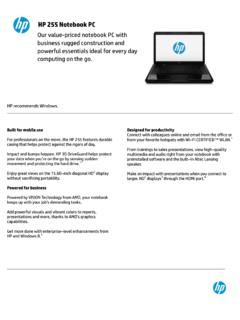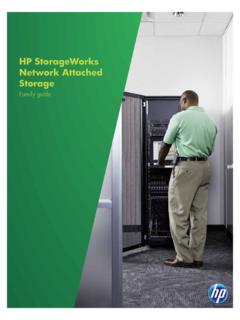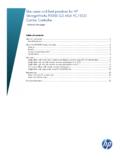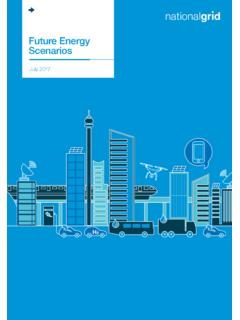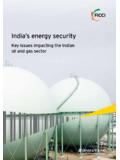Transcription of HP Carbon Footprint Calculator for Printing
1 Fact sheet Editorial contacts: Caitlin Roulston, HP +1 206 708 7651 Lindsey Burgess Porter Novelli for HP +1 206 770 7023 Hewlett-Packard Company 3000 Hanover Street Palo Alto, CA 94304 HP Carbon Footprint Calculator for Printing Overview The HP Carbon Footprint Calculator for Printing gives users the power to evaluate their energy consumption, paper use, Carbon output and the associated monetary costs of their Printing environment to understand how they can reduce their environmental impact through responsible Printing .(1) The newly improved, customer-friendly Calculator combines the capabilities of the existing Carbon Footprint Calculator for Printing and the HP LaserJet Power Calculator into one, robust tool. To help customers make more accurate assessments of the impact of their Printing , the Calculator allows head-to-head product comparisons or the ability to compare fleets of printers that range from current HP printers, legacy HP printers from the last 20 years and competitors printers from the last 10 years.
2 HP designed the HP Carbon Footprint Calculator for Printing to assess printer energy consumption and associated Carbon output, paper use and estimated monetary costs based on geographical energy assessments. The updated tool has been expanded to include geographic-specific information for more than 146 countries. Whether individuals at home or large enterprises, customers can compare product-specific energy usage of their current printers both inkjet and HP LaserJet with data from different HP products or competitors products to better understand and reduce their Carbon footprints. Offices can compare the Carbon Footprint of their current printer fleet to new, optimized fleets to understand the extent to which they can reduce their impact on the environment. Customers also can compare new HP printers with older models to illustrate energy savings in kilowatt hours and estimated dollars saved by simply upgrading older devices.
3 New features and benefits: The new Calculator offers separate tabs for different needs: one for customers doing head-to-head comparisons of specific printers and one for businesses assessing a fleet of printers The energy usage, Carbon Footprint and cost savings are calculated for both printer fleet measurement and individual printer comparisons The more powerful tool now measures the energy consumption of inkjet printers as well as HP LaserJet printers, providing a richer experience for all users and a comprehensive view of their HP inkjet and LaserJet portfolios Customers can now produce a head-to-head comparison of their HP printer to other printers, regardless of type, including competitive printers, newer HP printers and even older HP printers. Furthermore, customers have the ability to compare two devices The tool has increased worldwide reach by offering regionally localized output; for example, customers in Europe can view their savings in Euros per kWh, instead of dollars Calculations are based on 20 years of historical data for HP and 10 years for competitors, resulting in more accurate comparisons than the existing Carbon Footprint Calculator The new Calculator has a pull Printing percent savings button that calculates the positive impact of incorporating this networked print management feature.
4 Customers can reduce their paper consumption by 10 percent by using a pull Printing solution; the pull Printing feature eliminates wasted paper by not Printing jobs that might have otherwise been forgotten or discarded, translating into significant savings of energy , paper and supplies Users can customize information about their printer fleets, such as the percentage of duplex printers, or build a fleet of specific product types and quantities Pricing and availability The HP Carbon Footprint Calculator for Printing is free to all customers in 146 countries throughout the United States, Canada, Europe, Australia and Asia. (1) The Carbon Footprint Calculator generates estimates of energy consumption during use of a printer, emissions of Carbon dioxide from production of that electricity, and Carbon dioxide emissions from production of estimated volumes of paper consumed during Printing ( , estimated CO2 from electricity production and CO2 from paper production).
5 It is based on certain key assumptions and makes use of data and models generated by third parties. For more information visit: Key assumptions for the HP Carbon Footprint Calculator for Printing : a) "The Carbon Footprint Calculator generates estimates of energy consumption during use of a printer, emissions of Carbon dioxide from production of that electricity, and Carbon dioxide emissions from production of estimated volumes of paper consumed during Printing ( estimated CO2 from electricity production and CO2 from paper production). The Carbon Footprint Calculator also estimates the user s costs for the electricity and paper a printer consumes. It is based on certain key assumptions and makes use of data and models generated by third parties described below. b) The Carbon dioxide equivalent (CO2-e) results are for a 100 year global warming potential (GWP) horizon if default emission factors are employed by the user.
6 C) The energy consumption calculation assumes the printer has an 8 hour "workday" 5 days a week for every week in a year. When the printer is not Printing during the workday, it is assumed that the balance of the workday is spent half in ready mode and half in sleep mode. The balance of the week is assumed to be spent in sleep mode. Device is assumed to print at its maximum monochrome speed. The energy figure reported is the sum of the Printing energy , the workday standby energy , the workday sleep energy , and the non-workday sleep energy for the chosen time period. d) The electricity Carbon dioxide equivalent (CO2-e) factors used in the calculations comes from the following sources: Region Note All regions unless otherwise noted below 2005 CO2 Emissions per kWh from Electricity and Heat Generation. Source: Indirect CO2 Emissions from Purchased Electricity.
7 Version December 2007. Developed by World Resources Institute (WRI) and copyrighted. Available at Australia 2007 Full fuel cycle emissions factor. Source: National Greenhouse Accounts (NGA) Factors, January 2008, Commonwealth of Australia, Department of Climate Change. Available at Canada Source: Greenhouse Gas Division, Environment Canada, National Inventory Report, Greenhouse Gas Sources and Sinks in Canada - 1990-2005. (Submission to the United Nations Framework Convention on Climate Change), 2007, Tables A9-1 through A9-12 United Kingdom energy Suppliers' Fuel Mix Disclosure from 1 April 2006 to 31 March 2007. Source: energywatch. Available at United States Year 2004 Data. Source: eGrid2006 Version , United States of America, Environmental Protection Agency. Available at e) The default paper Carbon dioxide equivalent (CO2-e) factor used in the calculations is for a 100 year GWP horizon.
8 The default factor is from the process "paper, wood-containing, LWC, at regional storage/kg/RER" from the ecoinvent Centre (2007), ecoinvent data ecoinvent reports , Swiss Centre for Life Cycle Inventories, D bendorf, 2007, retrieved from: The impact method applied to the process is "IMPACT 2002+. Ref: Jolliet O, Margni M, Charles R, Humbert S, Payet J, Rebitzer G and Rosenbaum R (2003). IMPACT 2002+: A New Life Cycle Impact Assessment Methodology. Int J LCA 8 (6) 324-330. f) The currency list and exchange rates used in the calculations are from on 8/11/2008. g) The default electrical costs used in the calculations are for a regional average of industrial sector prices, or commercial prices where available, in 2006. Source: h) The default pages printed per employee assumption is according to the Lawrence Berkeley National Laboratory which states that the average US office worker uses 10,000 sheets of paper per year.
9 Source: Environmental energy Technologies Division, Lawrence Berkeley National Laboratory, United States Department of energy , Available at: i) The calculations assume that a page of paper is A4 size, 80 gsm weight or A size, 20 lb Bond. Each page is estimated to cost $ (USD). j) The Powering off daily scenario assumes that the device is put into an "off" power state via a switch at the end of every work day. The off power used in the calculations of Watts is for the average of the entire 2008 HP LaserJet printer and MFP lineup. k) The HP Web Jetadmin scenario assumes that each device in the fleet works with WJA. This scenario modifies the Current Fleet energy calculation such that each printer requires 29 minutes at the end of each work-day in standby mode prior to reaching sleep mode. The New Fleet uses WJA to automatically send each device into its sleep state at the end of every workday and thus retains the default energy calculation.
10 The default time to sleep given is for the average of the entire 2008 HP LaserJet printer and MFP lineup. l) The HP Universal Print Driver to increase your duplex rates assumes that all devices in the fleet can use UPD and have built-in duplexers. It also assumes a paper savings rate resulting from duplexing of 25% based on HP s internal study of UPD. m) The Pull Printing scenario assumes that all devices in the fleet have some means of Pull- Printing , either from HP or a third-party. It assumes a paper savings rate of 10% resulting from pull Printing . Source: Gartner. Cost Cutting Initiatives for Office Printing . Sharon McNee. 22 February 2008. 2008 Hewlett-Packard Development Company, The information contained herein is subject to change without notice. The only warranties for HP products and services are set forth in the express warranty statements accompanying such products and services.


